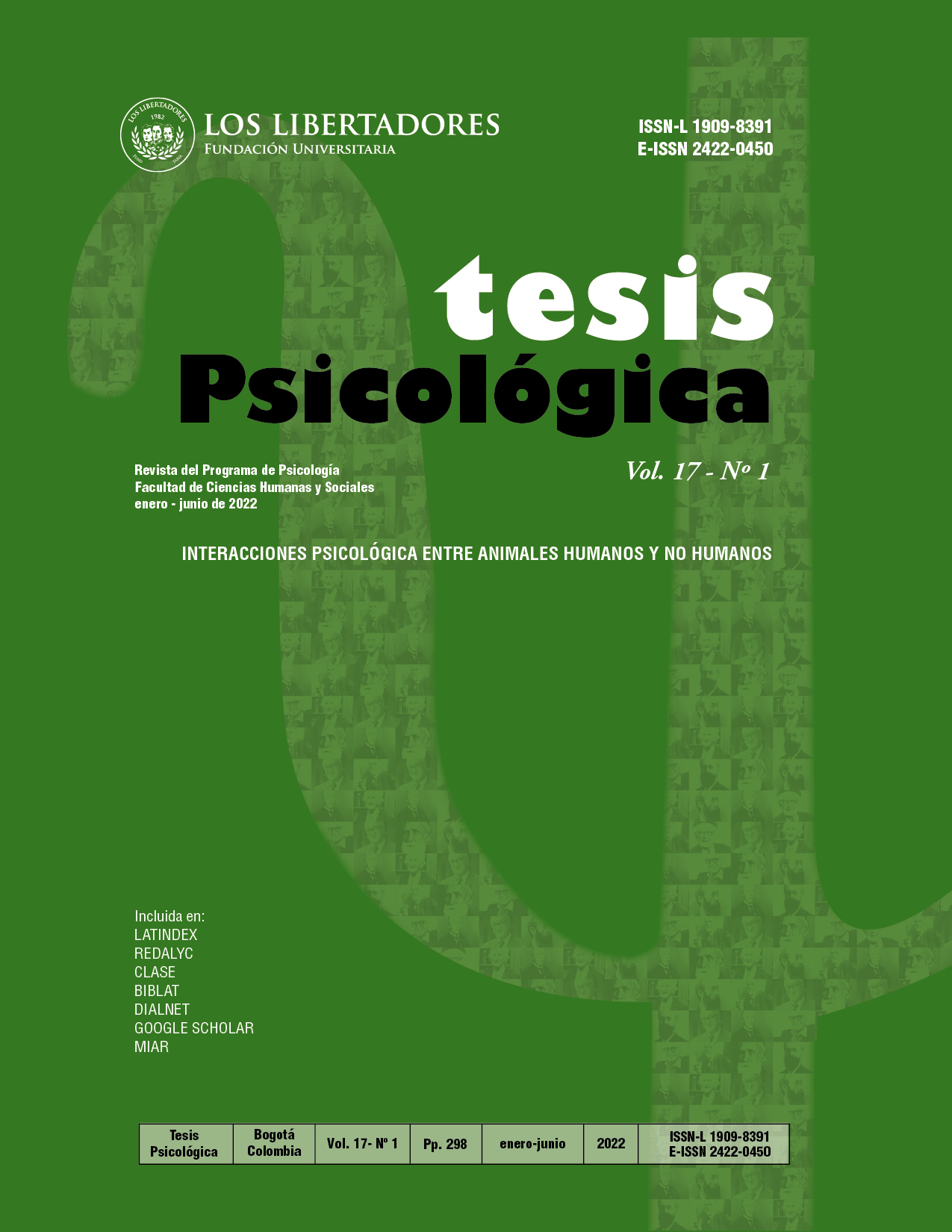Programas de intervención basados en tecnologías para niños y adolescentes diagnosticados con TDAH: una revisión sistemática
DOI:
https://doi.org/10.37511/tesis.v17n1a10Resumen
Antecedentes: El Trastorno por Déficit de Atención/Hiperactividad (TDAH) es una de las afecciones más frecuentes en la población de edad escolar con una prevalencia del 5%, manifestándose de tres formas: la presentación combinada, predominante con falta de atención y la presentación predominante hiperactiva/impulsiva. Objetivos del estudio: este estudio tuvo como objetivo realizar una revisión sistemática de la literatura para analizar la efectividad de aquellos programas de intervención basados en tecnologías como la realidad virtual, realidad aumentada, juegos serios y videojuegos para niños y adolescentes diagnosticados con TDAH. Metodología: se realizó una búsqueda sistemática en las bases de datos PubMed, ScienceDirect y Scielo de aquellos estudios publicados entre 2016 y 2021. De un total de 183 artículos identificados, 21 cumplieron con los criterios inclusión o exclusión. Se siguieron los parámetros de Preferred Reporting Items for Systematic Reviews and Meta-Analyses (PRISMA), y para reducir los sesgos se utilizó el checklist JBI Critical Appraisal Checklist for Analytical Cross-Sectional Studies (JBI-CSS). Resultados: la literatura encontrada demuestra la efectividad de las tecnologías en el diagnóstico, evaluación y rehabilitación de niños y adolescentes con TDAH. Conclusiones: implementar herramientas basadas en tecnología permiten mejorar la motivación la muestra, manejar diferentes estímulos que proporcionan entornos de aprendizaje, contribuir a la mejora de la sintomatología tanto en el ambiente escolar como en la vida cotidiana y mejorar habilidades no sólo cognitivas sino conductuales en los participantes.
Descargas
Referencias
Areces, D., Dockrell, J., García, T., González-Castro, P., & Rodríguez, C. (2018). Analysis of cognitive and attentional profiles in children with and without ADHD using an innovative virtual reality tool. PLoS ONE, 13(8), 1-18. https://doi.org/10.1371/journal.pone.0201039
Areces, D., García, T., Cueli, M., & Rodríguez, C. (2019). Is a Virtual Reality Test Able to Predict Current and Retrospective ADHD Symptoms in Adulthood and Adolescence?. Brain Sciences, 9(10), 1-8. https://doi.org/10.3390/brainsci9100274
Areces, D., Rodríguez, C., García, T., Cueli, M., & González-Castro, P. (2016). Efficacy of a Continuous Performance Test Based on Virtual Reality in the Diagnosis of ADHD and Its Clinical Presentations. Journal of Attention Disorders, 22(11), 1081-1091. https://doi.org/10.1177/1087054716629711
Avila-Pesantez, D., Vaca-Cardenas, L., Rivera, L.A., Aguayo, S., & Zuñiga, L. (2018). Towards the Improvement of ADHD Children through Augmented Reality Serious Games: Preliminary Results. EDUCON2021 – IEEE Global Engineering Education Conference, Santa Cruz de Tenerife, España. https://ieeexplore.ieee.org/document/8363318
Bashiri, A., Ghazisaeedi, M., & Shahmoradi, L. (2017). The opportunities of virtual reality in the rehabilitation of children with attention deficit hyperactivity disorder: a literature review. Korean Journal of Pediatrics, 60(11), 337-343. https://doi.org/10.3345/kjp.2017.60.11.337
Bioulac, S., De Sevin, E., Sagaspe, P., Claret, A., Philip, P., Micoulaud-Franchi, J. A., & Bouvard, M. P. (2018). [What do virtual reality tools bring to child and adolescent psychiatry?]. L’Encephale, 44(3), 280-285. https://doi.org/10.1016/j.encep.2017.06.005
Bioulac, S., Micoulaud-Franchi, J. A., Maire, J., Bouvard, M. P., Rizzo, A. A., Sagaspe, P., & Philip, P. (2018). Virtual Remediation Versus Methylphenidate to Improve Distractibility in Children With ADHD: A Controlled Randomized Clinical Trial Study. Journal of Attention Disorders. https://doi.org/10.1177/1087054718759751
Bougioukas, K.I., Bouras, E., Apostolidou-Kiouti, F., Kokkali, S., Arvanitidou M., Haidich, A. B. (2019). Reporting guidelines on how to write a complete and transparent abstract for overviews of systematic reviews of health care interventions, Journal of Clinical Epidemiology, 106(1), 70-79. https://doi.org/10.1016/j.jclinepi.2018.10.005
Bul, K. C. M., Doove, L. L., Franken, I. H. A., Oord, S. V., Kato, P. M., & Maras, A. (2018). A serious game for children with Attention Deficit Hyperactivity Disorder: Who benefits the most? PLoS ONE, 13(3), 1-18. https://doi.org/10.1371/journal.pone.0193681
Bul, K. C., Kato, P. M., Van Der Oord, S., Danckaerts, M., Vreeke, L. J., Willems, A., van Oers, H. J., Van Den Heuvel, R., Birnie, D., Van Amelsvoort, T. A., Franken, I. H., & Maras, A. (2016). Behavioral Outcome Effects of Serious Gaming as an Adjunct to Treatment for Children With Attention-Deficit/Hyperactivity Disorder: A Randomized Controlled Trial. Journal of Medical Internet Research, 18(2), 1-26. https://doi.org/10.2196/jmir.5173
Cabero, J., y García, F. (2016). Realidad aumentada. Tecnología para la formación. Síntesis. https://www.sintesis.com/data/indices/9788490772584.pdf
Climent, G., Rodríguez, C., García, T., Areces, D., Mejías, M., Aierbe, A., Moreno, M., Cueto, E., Castellá, J., & Feli González, M. (2021). New virtual reality tool (Nesplora Aquarium) for assessing attention and working memory in adults: A normative study. Applied Neuropsychology Adult, 28(4), 403-415. https://doi.org/10.1080/23279095.2019.1646745
Coleman, B., Marion, S., Rizzo, A., Turnbull, J., & Nolty, A. (2019). Virtual Reality Assessment of Classroom-Related Attention: An Ecologically Relevant Approach to Evaluating the Effectiveness of Working Memory Training. Frontiers in Psychology, 10(1), 1-9. https://doi.org/10.3389/fpsyg.2019.01851
Demontis, D., Walters, R. K., Martin, J., Mattheisen, M., Als, T.D., Agerbo, E., Baldursson, G., Belliveau, R., Bybjerg-Grauholm, J., Bækvad-Hansen, M., Cerrato, F., Chambert, K., Churchhouse, C., Dumont, A., Eriksson, N., Gandal, M., Goldstein, J. I., Grasby, K.L., Grove, J.,… Neale, B. M. (2019). Discovery of the first genome-wide significant risk loci for attention deficit/hyperactivity disorder. Nature Genetics, 51(1), 63-75. https://doi.org/10.1038/s41588-018-0269-7
Díaz-Orueta, U., Fernández-Fernández, M. A., Morillo-Rojas, M. D., & Climent, G. (2016). Efficacy of lisdexamphetamine to improve the behavioural and cognitive symptoms of attention deficit/hyperactivity disorder: treatment monitored by means of the AULA Nesplora virtual reality test. Revista Neurología, 63(1), 19-27. https://doi.org/10.33588/rn.6301.2015488
Eom, H., Kim, K. K., Lee, S., Hong, Y. J., Heo, J., Kim, J. J., & Kim, E. (2019). Development of Virtual Reality Continuous Performance Test Utilizing Social Cues for Children and Adolescents with Attention-Deficit/Hyperactivity Disorder. Cyberpsychology, Behavior and Social Networking, 22(3), 198-204. doi: https://doi.org/1089/cyber.2018.0377
Erskine, H. E, Norman, R. E., Ferrari, A. J., Chan, G. C., Copeland, W. E., Whiteford, H. A., & Scott, J. G. (2016). Long-term outcomes of attention-deficit/ hyperactivity disorder and conduct disorder: a systematic review and meta-analysis. Journal of the American Academy of Child and Adolescent Psychiatry, 55(10), 841–50. https://doi.org/10.1016/j.jaac.2016.06.01
Fang, Y., Han, D., Luo, H. (2019). A virtual reality application for assessment for attention déficit hyperactivity disorder in School-aged children. Neuropsychiatric Disease and Treatment, 15(1), 1517-1523. https://doi.org/10.2147/NDT.S206742
Faraone, S. V., Asherson, P., Banaschewski, T., Biederman, J., Buitelaar, J. K, Ramos-Quiroga, J. A., Rohde, L. A., Sonuga-Barke, E. J., Tannock, R., & Franke, B. (2015). Attention-deficit/hyperactivity disorder. Natural Reviews Disease Primers, 6(1), 1-23. https://doi.org/10.1038/nrdp.2015.20
Faraone, S. V., Newcorn, J. H., Antshel, K. M., Adler, L., Roots, K., & Heller, M. (2016). The Groundskeeper Gaming Platform as a Diagnostic Tool for Attention-Deficit/Hyperactivity Disorder: Sensitivity, Specificity, and Relation to Other Measures. Journal of Child and Adolescent Psychopharmacology, 26(8), 672-685. https://doi.org/10.1089/cap.2015.0174
García, T., Rodríguez, C., Rodríguez, J., Fernández-Suárez, A., Richarte, V., & Ramos-Quiroga, J. A. (2019). Psychosocial profiles of adults with ADHD: A comparative study of prison and outpatient psychiatric samples. The European Journal of Psychology Applied to Legal Context, 11(1), 41-49. https://doi.org/10.5093/ejpalc2018a14
Gwet, K. L. (2014). Handbook of Inter-Rater Reliability: The Definitive Guide to Measuring the Extent of Agreement (4th ed.). Advanced Analytics LLC. https://www.researchgate.net/publication/267922774_Handbook_of_inter-rater_reliability_The_definitive_guide_to_measuring_the_extent_of_agreement_among_raters
Hall, C. L., Valentine, A. Z., Groom, M. J., Walker, G. M., Sayal, K., Daley, D., & Hollis, C. (2016). The clinical utility of the continuous performance test and objective measures of activity for diagnosing and monitoring ADHD in children: A systematic review. European Child & Adolescent Psychiatry, 25(7), 677-699. https://doi.org/10.1007/s00787-015-0798-x
Higgins, J., & Green, S. (2011). Cochrane Handbook for Systematic Reviews of Interventions Version 5.1.0. The Cochrane Collaboration. https://www.cochrane-handbook.org/
Iriarte, Y., Diaz-Orueta, U., Cueto, E., Irazustabarrena, P., Banterla, F., & Climent, G. (2016). AULA-advanced virtual reality tool for the assessment of attention: Normative study in Spain. Journal of Attention Disorders, 20(6), 542-568. https://doi.org/10.1177/1087054712465335
Johnstone, S. J., Roodenrys, S. J., Johnson, K., Bonfield, R., & Bennett, S. J. (2017). Game-based combined cognitive and neurofeedback training using Focus Pocus reduces symptom severity in children with diagnosed AD/HD and subclinical AD/HD. International Journal of Psychophysiology, 116(1), 32-44. https://doi.org/10.1016/j.ijpsycho.2017.02.015
Keshav, N. U., Vogt-Lowell, K., V., Vahabzadeh, A., & Sahin, N. T. (2019). Digital Attention-Related Augmented-Reality Game: Significant Correlation between Student Game Performance and Validated Clinical Measures of Attention-Deficit/Hyperactivity Disorder (ADHD). Children (Basel, Switzerland), 6(6), 1-13. https://doi.org/10.3390/children6060072
Lau, H. M., Smit, J. H., Fleming, T. M., & Riper, H. (2017). Serious Games for Mental Health: Are They Accessible, Feasible, and Effective? A Systematic Review and Meta-analysis. Frontiers in Psychiatry, 7(1), 1-13. https://doi.org/10.3389/fpsyt.2016.00209
Liberati, A., Altman, D. G., Tetzlaff, J., Mulrow, C., Gøtzsche, P. C., Ioannidis, J. P. A., Clarke, M., Devereaux, P. J., Kleijnen, J., & Moher, D. The PRISMA statement for reporting systematic reviews and meta-analyses of studies that evaluate health care interventions: explanation and elaboration. Journal of Clinical Epidemiology, 62(1), 1-34. https://doi.org/10.1016/j.jclinepi.2009.06.006
Masi, L., Abadie, P., Herba, C., Emond, M., Gingras, M-P., & Amor, L. B. Video Games in ADHD and Non-ADHD Children: Modalities of Use and Association With ADHD Symptoms. Frontier in Pediatrics, 9(1), 1-10. https://doi.org/10.3389/fped.2021.632272
Miranda, A., Colomer, C., Berenguer, C., Roselló, R., & Roselló, B. (2016). Substance use in young adults with ADHD: Comorbidity and symptoms of inattention and hyperactivity/impulsivity. International Journal of Clinical and Health Psychology, 16(2), 157-165. https://doi.org/10.1016/j.ijchp.2015.09.001
Moher, D., Liberati, A., Tetzlaff, J., Altman, D. G., & The Prisma Group. (2009). Preferred Reporting Items for Systematic Reviews and Meta-Analyses: The PRISMA Statement. PLoS Medicine, 6(7), 1-6. https://doi.org/10.1371/journal.pmed.1000097
Moher, D., Tetzlaff, J., Tricco, A. C., Sampson, M., & Altman, D. G. Epidemiology and Reporting Characteristics of Systematic Reviews. (2007). PLoS MEDICINE, 4(3), 0047-0455. https://doi.org/10.1371/journal.pmed.0040078
Moola, S., Munn, Z., Tufanaru, C., Aromataris. E., Sears, K., Sfetcu, R., Currie, M., Qureshi, R., Mattis, P., Lisy, K., & Mu, P. F. (2020). Chapter 7: Systematic review of ethiology risk: Analytical cross-sectional studies Critical Appraisal Tool. In E. Aromataris, Z. Munn (Eds.) Joanna Briggs Institute Reviewer’s Manual. (pp. 1-5). JBI. https://jbi.global/sites/default/files/2019-05/JBI_Critical_Appraisal-Checklist_for_Analytical_Cross_Sectional_Studies2017_0.pdf
Mühlberger, A., Jekel, K., Probst, T., Schecklmann, M., Conzelmann, A., Andreatta, M., Rizzo, A. A., Pauli, P., & Romanos, M. (2016). The Influence of Methylphenidate on Hyperactivity and Attention Deficits in Children With ADHD: A Virtual Classroom Test. Journal of Attention Disorders. https://doi.org/10.1177/1087054716647480
Negut, A., Jurma, A. M., & David, D. (2016). Virtual-reality-based attention assessment of ADHD: ClinicaVR: Classroom-CPT versus a traditional continuous performance test. Child Neuropsychology, 23(6), 692-712. https://doi.org/10.1080/09297049.2016.1186617
Nolin, P., Stipanicic, A., Henry, M., Lachapelle, Y., Lussier-Desrochers, D., Rizzo, A. S., Philippe, A. ClinicaVR: Classroom-CPT: a virtual reality tool for assessing attention and inhibition in children and adolescents. Computers in Human Behavior, 59(1), 327–333. https://doi.org/10.1016/j.chb.2016.02.023
Parsons, T. D., Carlew, A. R., Magtoto, J., & Stonecipher, K. (2017). The potential of function-led virtual environments for ecologically valid measures of executive function in experimental and clinical neuropsychology. Neuropsychological Rehabilitation, 27(5), 777-807. https://doi.org/10.1080/09602011.2015.1109524
Paulus, F. W., Ohmann, S., von Gontard, A., & Popow, C. (2018). Internet gaming disorder in children and adolescents: a systematic review. Developmental Medicine and Child Neurology, 60(7), 645-659. https://doi.org/10.1111/dmcn.13754
Randolph, J. (2010). Free-Marginal Multirater Kappa (multirater κfree): An Alternative to Fleiss' Fixed-Marginal Multirater Kappa. https://www.researchgate.net/publication/224890485_Free-Marginal_Multirater_Kappa_multirater_kfree_An_Alternative_to_Fleiss_Fixed-Marginal_Multirater_Kappa
Robaey, P., McKenzie, S., Schachar, R., Boivin, M., & Bohbot, V. D. (2016). Stop and look! Evidence for a bias towards virtual navigation response strategies in children with ADHD symptoms. Behavioural Brain Research, 298(1), 48-54. https://doi.org/10.1016/j.bbr.2015.08.019
Rodríguez, C., Areces, D., García, T., Cueli, M., & González-Castro, P. (2018). Comparison between two continuous performance tests for identifying ADHD: Traditional vs. virtual reality. International Journal of Clinical and Health Psychology, 18(3), 254-263. https://doi.org/10.1016/j.ijchp.2018.06.003
Rodríguez, C., García, T., & Areces, D. New and Future Challenges Concerning the Use of Virtual Reality Tools for Assessing ADHD. (2017). Current Developmental Disorders Reports, 4(1), 8-10. https://doi.org/10.1007/s40474-017-0103-4
Schmalstieg, D., & Höllerer, T. (2016). Augmented reality: principles and practice. Addison-Wesley. https://arbook.icg.tugraz.at/Schmalstieg-2016-AW
Shema-Shiratzky, S., Brozgol, M., Cornejo-Thumm, P., Geva-Dayan, K., Rotstein, M., Leitner, Y., Hausdorff, J. M., & Mirelman, A. (2018). Virtual reality training to enhance behavior and cognitive function among children with attention-deficit/hyperactivity disorder: brief report. Developmental neurorehabilitation, 22(6), 431-436. https://doi.org/10.1080/17518423.2018.1476602
Storebø, O. J., Pedersen, N., Ramstad, E., Kielsholm, M. L., Nielsen, S. S., Krogh, H. B., Moreira-Maia, C. R., Magnusson, F. L., Holmskov, M., Gerner, T., Skoog, M., Rosendal, S., Groth, C., Gillies, D., Buch Rasmussen, K., Gauci, D., Zwi, M., Kirubakaran, R., Håkonsen, S. J., Aagaard, L.,… Gluud, C. Methylphenidate for attention deficit hyperactivity disorder (ADHD) in children and adolescents – assessment of adverse events in nonrandomised studies (Review). Cochrane Database of Systematic Reviews, (5). https://doi.org/10.1002/14651858.CD012069.pub2
Vahabzadeh, A., Keshav, N. U., Salisbury, J. P., Sahin, N. T. (2018). Improvement of Attention-Deficit / Hyperactivity Disorder Symptoms in School-Aged Children, Adolescents, and Young Adults With Autism via a Digital Smartglasses-Based Socioemotional Coaching Aid: Short-Term, Uncontrolled Pilot Study. JMIR Mental Health, 5(2), 1-25. https://doi.org/10.2196/mental.9631
Weerdmeester, J., Clima, M., Granic, I., Hashemian, Y., & Gotsis, M. (2016). A Feasibility Study on the Effectiveness of a Full-Body Videogame Intervention for Decreasing Attention Deficit Hyperactivity Disorder Symptoms. Games for Health Journal, 5(4), 258-269. https://doi.org/10.1089/g4h.2015.0103
Xu, G., Strathearn, L., Liu, B., Yang, B., & Bao, W. (2018). Twenty-Year Trends in Diagnosed Attention-Deficit/Hyperactivity Disorder Among US Children and Adolescents, 1997-2016. JAMA Network Open, 1(4), 1–9. https://doi.org/10.1001/jamanetworkopen.2018.1471
Descargas
Publicado
Número
Sección
Licencia
Derechos de autor 2022 Tesis Psicológica

Esta obra está bajo una licencia internacional Creative Commons Atribución-NoComercial-CompartirIgual 4.0.

Esta obra está bajo una Licencia Creative Commons Atribución-NoComercial-















